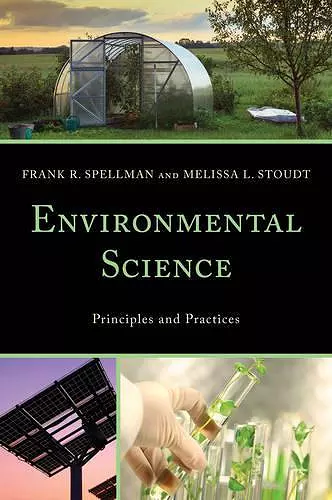Environmental Science
Principles and Practices
Frank R Spellman author Melissa L Stoudt author
Format:Hardback
Publisher:Scarecrow Press
Published:14th Feb '13
Currently unavailable, and unfortunately no date known when it will be back

Environmental Science: Principles and Practices provides the scientific principles, concepts, applications, and methodologies required to understand the interrelationships of the natural world, identify and analyze environmental problems both natural and manmade, evaluate the relative risks associated with these problems, and examine alternative solutions (such as renewable energy sources) for resolving and even preventing them. Frank R. Spellman and Melissa Stoudt introduce the science of the environmental mediums of air, water, soil, and biota to undergraduate students.
Interdisciplinary by nature, environmental science embraces a wide array of topics. Environmental Science: Principles and Practices brings these topics together under several major themes, including
How energy conversions underlie all ecological processesHow the earth’s environment functions as an integrated systemHow human activities alter natural systemsHow the role of culture, social, and economic factors is vital to the development of solutionsHow human survival depends on practical ideas of stewardship and sustainability
Environmental Science: Principles and Practices is an ideal resource for students of science in the classroom and at home, in the library and the lab.
This volume—arranged into 5 parts and 18 chapters—provides a thorough introduction to the study of environmental science and its many related fields of study. Each chapter begins with a short quote or anecdote, a list of chapter objectives and an outline, a list of key terms, and an introduction to the subject at hand. The first of the five sections focuses on providing foundational knowledge critical to the study and understanding of environmental science, while the following sections focus more closely on air quality, water quality, soil science, and solid and hazardous waste. Each chapter closes with a short summary, a list of suggested discussion questions and problems, a list of suggested research topics and projects, notes, and a list of references and recommended reading. Black and-white images and illustrations are included throughout the text. The charts and illustrations are generally useful. 'Did You Know?' boxes appear through the book to highlight key information and quick facts. Boxed sections featuring 'Response Scenarios' offer sample situations as well as suggested questions to prompt further thought and discussion. 'Case Studies' also appear in shaded boxes and offer real-world examples of relevant topics. The text concludes with a comprehensive glossary and an index. The authors provide a balanced discussion of the practices by humans that are harmful to the environment while also presenting possible solutions. Intended for undergraduate students and general readers, this set would be a worthwhile resource for academic and public libraries. High-school libraries where AP classes on environmental science are taught would also find this volume to be useful. * Booklist *
Frank R. Spellman and Melissa Stoudt’s Environmental Science: Principles and Practices demonstrates the interdisciplinary aspects of environmental science and how our air, water, and soil are affected by a complex array of factors. Providing the information about scientific principles, applications, concepts, and methodologies, this resource gives the student a more comprehensive idea of the interrelationship of human beings, technology, weather and a wide range of other variables and how all of these combined forces affect the differing environments in which human beings live on our planet. Because this source provides a detailed look at endangered species, hazardous wastes, acid rain, ozone depletion, and pollution of our air, water, and soil by manufacturing, pesticides, auto emissions, and more, it would be an excellent textbook or essential reference resource for faculty and students. The organization and special features enhance its value. Each chapter provides objectives, key terms, discussion questions, a bibliography, real-life examples, and suggested research topics for students. This volume, also available as an e-book, will help build a foundation for anyone interested in the current and emerging environmental issues that are changing and will continue to change the way we live. * American Reference Books Annual *
ISBN: 9780810886100
Dimensions: 264mm x 188mm x 49mm
Weight: 1674g
732 pages